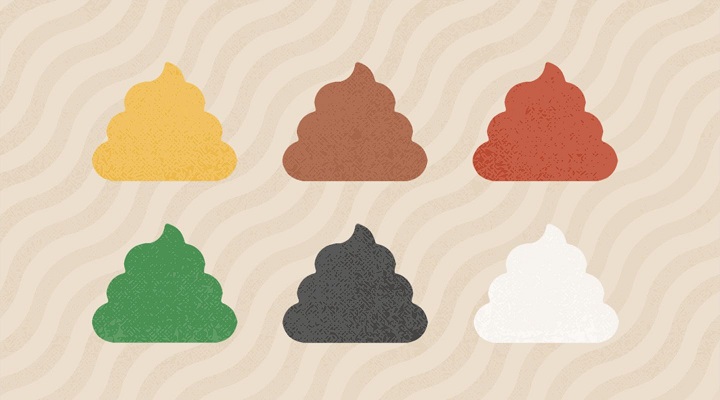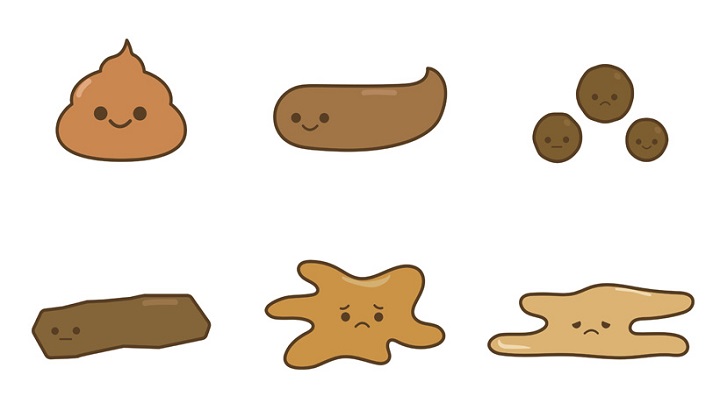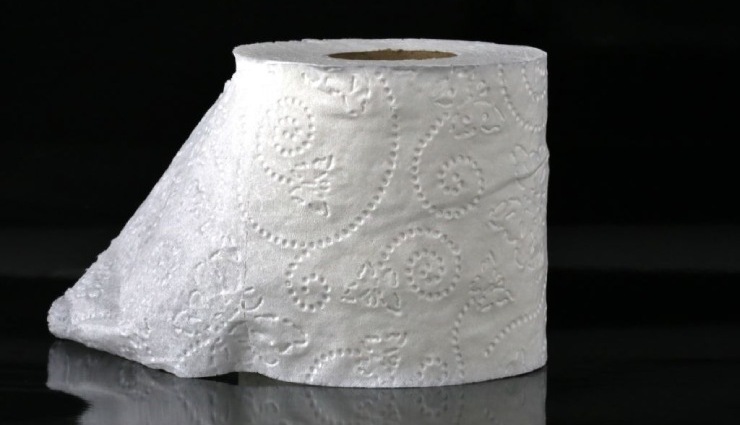The texture and color of stool give you much information about your health. Maybe you have never paid attention to your seat, but it will familiarize you with its standard color and shape and quickly notice any changes. Of course, sometimes changing the color of feces is normal and occurs due to the consumption of different foods, but the unusual color and shape of feces are worrying in the long term and need to be checked by a doctor. Continue reading to learn more about dangerous or regular stool color changes.
What is the standard color of stool?
The natural color of stool is usually brown or greenish brown. Depending on your food and the amount of bile in your seat, this color may change. Bile is a substance produced by the liver to digest fats. This substance has a yellowish-green color at first, but when it passes through the digestive system, it changes color to brown due to chemical changes. It is better to tell your doctor about any change in stool color unrelated to your diet.
What does each stool color indicate?

1. Pale stools
Bile salts in the intestines cause a natural brown color. The reason for lightening the stool color (pale, white, gray, or earthy) is usually the lack of bile in the stool. Obstruction of the bile ducts due to gallstones or a disease that affects the gallbladder, liver, or pancreas can reduce bile secretion. Hepatitis and the presence of a tumor are two examples of complications that cause white stools.
If your stool is white, earthy, or chalky gray, you should see your doctor, especially if this stool color persists after a few days. White or light stools may also be shiny, greasy, floaty, and smelly in case of oily diarrhea. However, remember that the stool will be temporarily pale after the barium enema test.
2. yellow stool
Various factors may cause stool to turn yellow, and this color may be a sign of essential or minor complications. Having yellow chairs can indicate eating yellow foods such as sweet potatoes, carrots, turmeric, or yellow food coloring. Also, people with gastroesophageal reflux disease (GERD) or who take medications for this condition sometimes have yellow stools.
The sudden onset of yellow stool can indicate an intestinal infection, especially if it accompanies diarrhea, fever, flu symptoms, or abdominal pain. Yellow chairs have also been seen after the condition of Covid-19. Giardiasis is an infection of the small intestine caused by the parasite Giardia lamblia and can cause yellow stools or diarrhea.
Sometimes having a yellow stool is a sign of excess fat in the chair (steatorrhea). This complication occurs due to any disease that causes a malfunction of the intestinal wall, such as celiac disease or diseases that affect the pancreas, liver, or bile. Fatty diarrhea usually has a greasy or frothy appearance and an unpleasant smell and floats. Also, it usually sticks to the toilet stone and is challenging to wash.
Some people have yellow stools after gallbladder removal surgery. The reason is that more bile flows directly into the intestines and causes yellow watery diarrhea.
Diarrhea and stool color in babies
It is usual for the stool color of breastfed babies to be yellow and loose in texture because breast milk quickly passes through the digestive system. Yellow stool color is also standard for children who use formula, but this stool is usually less watery. When you add solid foods to your baby’s diet, their chairs should become firmer and browner.
3. green stool
Some causes of green stools are entirely typical. Eating leafy vegetables such as spinach or kale may cause green stools. This is normal and should not prevent you from consuming these antioxidant-rich foods. Iron supplements and green, purple, and blue food dyes can also cause bright green stools.
Conditions that speed up bowel movements, such as colon disorders and poisoning, can cause green stools or diarrhea. At certain times of pregnancy, the seat becomes green.
4. Orange poop
Stools can be the color of your food, especially when you have diarrhea. Sometimes orange stools are caused by eating orange foods such as carrots, pumpkins, pumpkins, and sweet potatoes. Foods containing orange food colorings, such as soft drinks, candy, and jelly, can also turn stool orange.
Antibiotics and antacids that contain aluminum hydroxide also turn stool orange. In rare cases, orange stools may be caused by liver problems, reduced bile production, or a blockage that prevents bile from being released from the liver. Of course, the chair usually becomes pale or earthy in this situation.
5. Bright red stools
Bright red stools can be caused by consuming beets, raspberries, tomato juice or soup, and products that have red food coloring. Red drugs like amoxicillin can also make your stool red. If there is blood in the chair, the color of the stool depends on the location of the bleeding in the digestive tract. Blood from the upper parts of the digestive tract, such as the stomach or esophagus, darkens until it reaches the stool.
Bright red blood usually comes from the lower part of the digestive tract, such as the colon and anus. Hemorrhoids, anal fissures, ulcerative colitis, diverticula, or colon cancer may cause this bleeding. Blood in the stool does not always appear bright red. This blood may not be visible in the chair, called “occult blood.” A fecal occult blood test is commonly used to diagnose these types of bleeding.
6. Black stool color
Some foods, supplements, and medications can temporarily cause black stools, including:
- bismuth subsalicylate;
- iron supplement;
- activated charcoal supplements;
- Dark foods such as blueberries, dark biscuits, blackberries, and blueberries.
Constipation may also make the stool appear darker. Dark green stools are caused by bile that has not had a chance to break down and may appear black in some lights. Stools that are black, dark, or tar-like and complex can be a sign of bleeding in the upper parts of the digestive tract. Diseases that cause dark or tarry stools include:
- Stomach ulcer ;
- Varicose veins of the esophagus;
- Rupture of the esophageal valve to the stomach;
- Gastritis (stomach inflammation).
Different shapes of feces

If the stool has a different texture from time to time, it is normal and usually caused by food. Of course, if these changes persist after several bowel movements, it is better to contact your doctor.
1. Stool that settles quickly
Although each person’s normal stool looks different, if the chair settles quickly, the person’s diet may not get enough fluids or fiber. This type of stool is usually darker in color because it stays in the intestines longer.
2. floating stool
If the stool glides occasionally, it is usually nothing to worry about. In most cases, chair floats due to increased fat volume. Also, this happens after consuming carbonated drinks, beans, and sugary foods. Some gastrointestinal diseases, such as irritable bowel syndrome, can cause floating stools. Of course, if the seat is constantly flowing, it can indicate impaired fat absorption.
3. Pebble stools
Feces that are excreted as small pieces are called pebbly stools. Fibers create a gel in the intestines that is broken down by intestinal bacteria and combined with water. If there is not enough fiber to hold the stool together, it may pass as small stones. Increasing the amount of fiber intake helps to treat this condition. To do this, slowly increase your daily fiber intake to reach the recommended 28 grams. You can use a fiber supplement if you have trouble eating fiber-rich foods.
4. loose stools
Loose stools or diarrhea that only lasts a few days is common and is usually nothing to worry about. This complication can be caused by consuming different foods, supplements, and medicines. For example, consuming too much fructose (a type of sugar found in honey and many carbonated drinks and processed foods) can cause diarrhea. Another common cause of diarrhea is a gastrointestinal infection or stomach flu.
When should you see a doctor?
Although the stool may change daily depending on the foods and drinks consumed, the seat should be brown. Also, the chair should pass without much effort or discomfort, have a texture like toothpaste, and look more like a banana than a thin pencil.
If the color of the stool is bright red, black, or white, accompanied by mucus or pus, or if you have other unusual symptoms, such as pain, see a doctor.
Common questions about stool shape and color
1. What is the color of normal stool?
Normal stool is usually brown. Of course, this color changes according to the food you have consumed and the amount of bile in the chair, and the color is greenish-brown.
2. Is whitish stool normal?
No Pale, earthy, or white stools can indicate liver, pancreas, gallbladder, or bile duct problems. See a doctor immediately if this condition is accompanied by fever, abdominal pain, or yellow skin.
3. Is passing bloody stool dangerous?
It may be so. This condition may be caused by hemorrhoids or a superficial tear near the anus. Still, it can also be an early sign of a more severe problem, such as a tumor, colitis infection, or inflammatory bowel syndrome. If you are unsure about the cause of the bleeding, consult your doctor.
final word
Various factors affect the appearance of stool. Some factors, such as daily diet, are not problematic but be aware that some seemingly harmless changes in stool color, shape, or texture, such as stool that is as thin as a pencil, can be a sign of severe and dangerous diseases. If you notice changes in your excretion pattern or other symptoms, seeing a doctor and determining the cause is better.
Warning! This article is only for educational purposes; to use it, it is necessary to consult a doctor or specialist.



